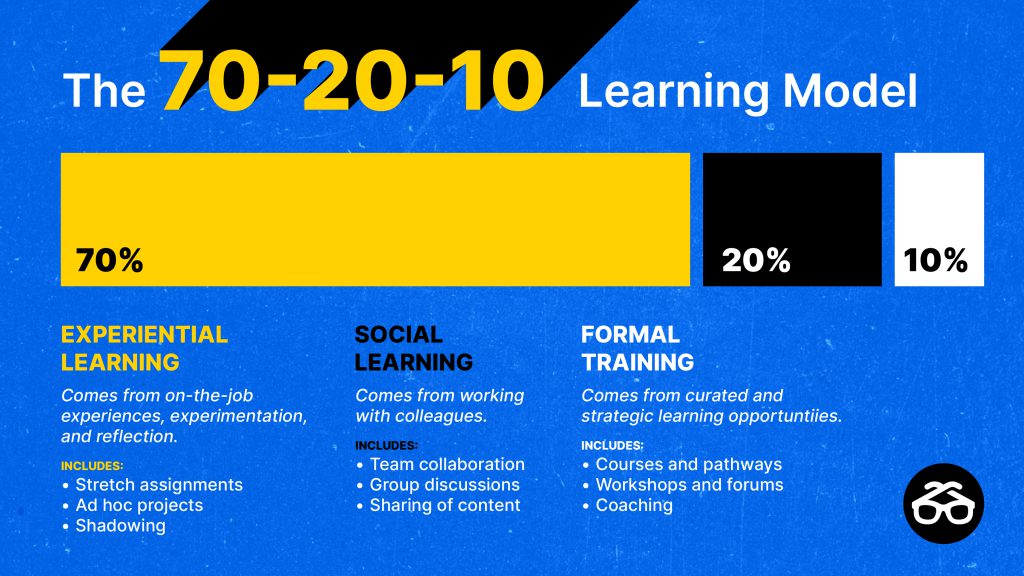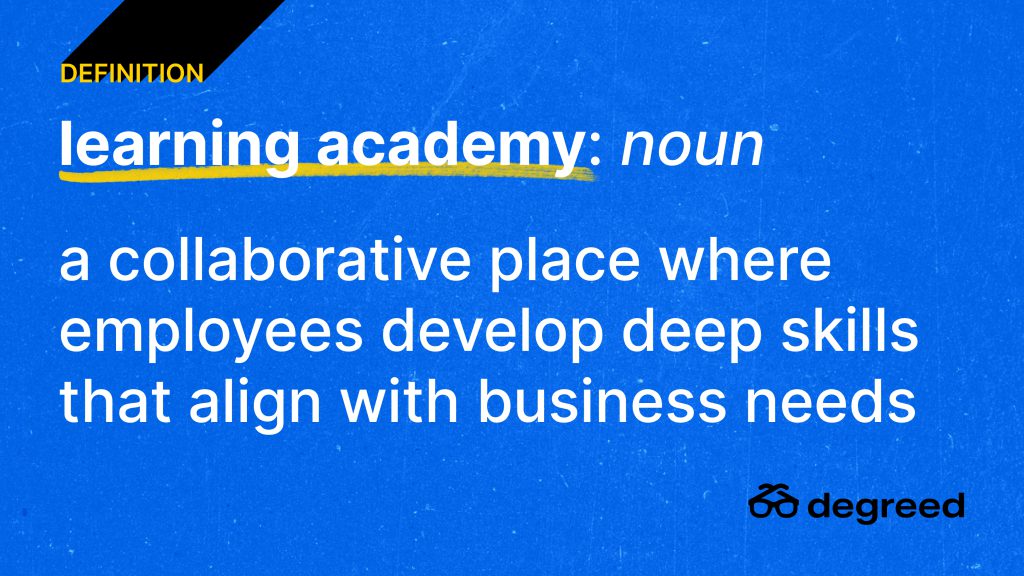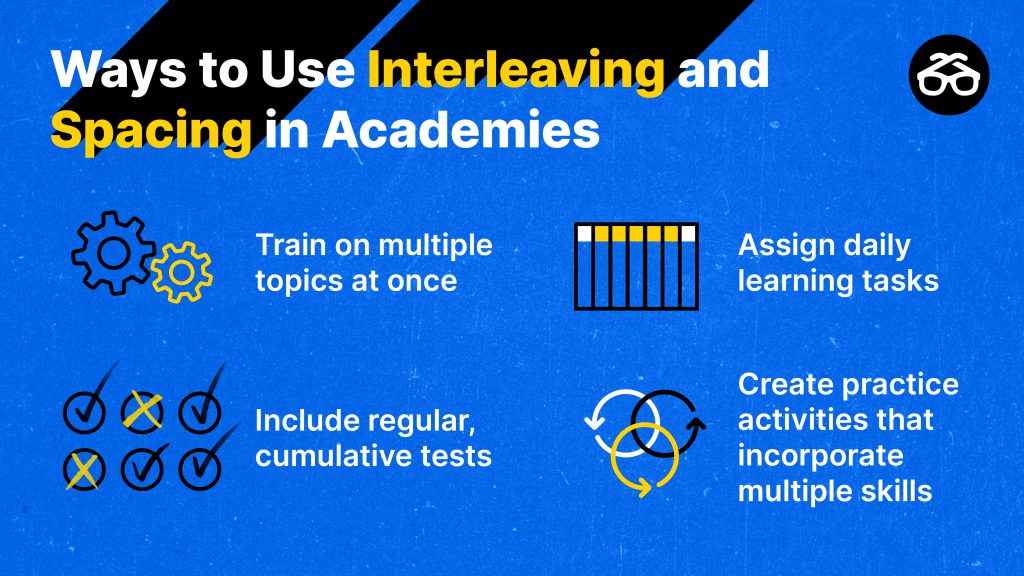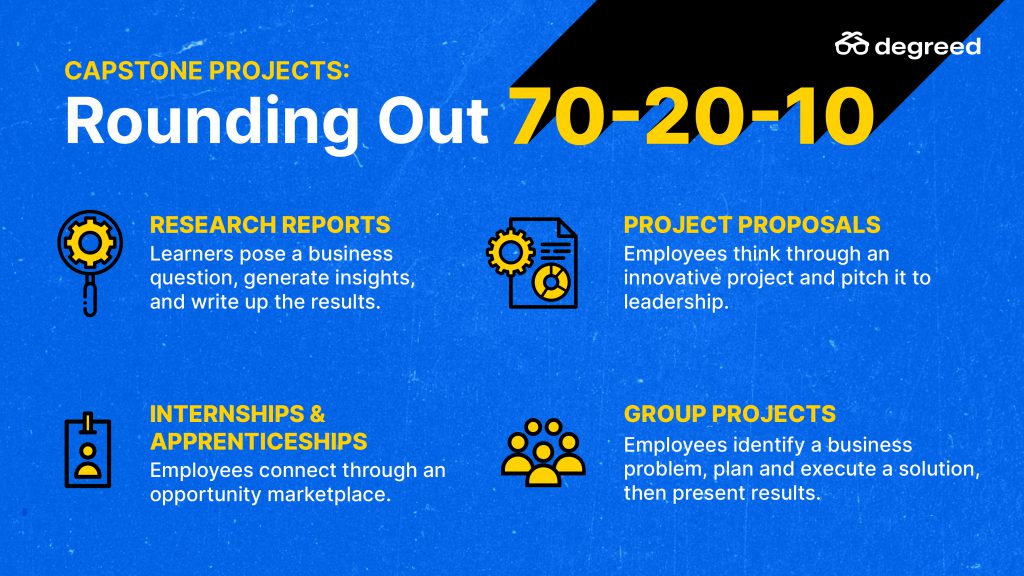People say “you’ll never forget how to ride a bike.” Why is that?
Well, learning a skill so deeply that it never leaves you is a complex process—and finding ways to teach skills deeply at scale is even harder. But that’s exactly what L&D professionals have been trying to do for decades.
It’s what Charles Jennings wanted to accomplish in the 1990s when he created the 70-20-10 learning model based on how he’d observed people learned: with a ratio of around 70% experiential learning, 20% social learning, and 10% formal training. Since then, countless organizations have divvied up their L&D resources according to this ratio.

More recently, industry analyst Josh Bersin, founder and CEO of the Josh Bersin Company, has advocated for an academy-based approach. He’s called academies the future of learning at work, and we agree with him. But that doesn’t mean that the 70-20-10 model (or a host of other approaches, for that matter) have to be left in the dust. In fact, you can build learning academies that align with 70-20-10 — and include other tactics that enhance learning programs even further like contextual learning, cognitive wobble, interleaving and spacing, and capstone projects.
What are learning academies?
Bersin describes the modern learning academy as a “place to learn,” where numerous learning resources and modalities come together. A learning academy is a skill-based experience that hones in on relevant, focused, and personalized learning at scale. An academy focuses on driving mastery and confidence—two things that helped me learn to ride a bike as a kid.
If that sounds open-ended, you’re right. Academies are flexible and can align with your business goals, whether that’s boosting sales, keeping up with rapidly evolving technologies, or developing skilled leaders.

70-20-10: Thinking Outside the Box
Unlike many learning opportunities, academies don’t have to fit into one of Jennings’ three 70-20-10 pillars. Instead, think of the academy as a box—a container large enough to hold all three pillars.
A holistic 70-20-10-based academy could include:
- Formal training: Regular lessons that form the knowledge base of the learning experience.
- Social learning: Cohorts that group employees of similar skill levels so they can support each other, share ideas, and give feedback.
- Experiential learning: Hands-on projects and assignments that translate knowledge into practical job skills.
Beyond 70-20-10: Content vs. Context
Imagine you’re a cycling coach and you want to teach cycling at scale in an academy setting. You might start by showing learners the basics of how the bike works, where the brakes are, and how to balance on two wheels. You might include some YouTube videos, a labeled diagram of a bicycle and its parts, and a before-you-ride checklist. This is content, and it’s critical for imparting knowledge.
But students can’t learn to ride a bike from YouTube. They need context to apply skills on the open road. They have to feel how to balance. They have to pull back on the brakes to get a sense of how the bike stops. And they have to topple over a few times to know how to take a turn. Context comes from applying knowledge. Doing, rather than knowing.
Incorporating a range of modalities, an academy can deliver context from multiple sources, including:
- Peers: Discussion prompts inspire employees to share their experiences.
- Instructors: Live events create real-time interaction among workers.
- Work: Projects require practicing skills in hypothetical situations.
- Industry expertise: External certifications or courses make real-world applications clear.
As you can see, context can also align with the two larger pillars of the 70-20-10 framework — experiential and social learning — and tip the balance in their direction.
Cognitive Wobble: Right-sizing Challenges
Cycling primarily builds quad, glute, and calf muscles, while academies typically build mental muscles. Strengthening physical and mental muscles requires struggle. Right-sizing that struggle in ways that don’t overwhelm learners is critical to their growth.
James Nottingham, best-selling author of Challenging Learning, describes his approach to teaching people: “Instead of giving them clarity, [my purpose is] creating confusion, or cognitive wobble. Like when you are learning to ride a bike and it wobbles—I am trying to create that mental wobble so they have to think about it more.”
Although Nottingham applies his strategies to child education, cognitive wobble can maximize adult learning too. Nursing students who participated in productive failure—or trying to solve a problem before being taught how—reported that the struggle helped them learn.
The key is finding the sweet spot between challenging and overwhelming. You wouldn’t send a novice cyclist down a steep mountain trail, nor would you give a world champion training wheels. Nottingham identifies three mental states shared by learners. People learning are: relatively comfortable, relatively uncomfortable, or panicked. Academies can help you make learners relatively uncomfortable. How? You can admit them at any level and personalize their learning journeys.
Applying the 70-20-10 Model: Activities that initially encourage failure bring in experiential and social learning before formal training occurs — giving you more opportunities to bolster learning that's hands-on and collaborative.
Interleaving, Spacing, and Retrieval
Whatever level your cycling students start at, you wouldn’t teach just one concept at a time, nor would you only train on Saturdays. You’d have them train daily, and you’d alternate between activities. Leg days might be Mondays and Thursdays. Core days might be Tuesdays and Fridays. On Wednesdays, you might switch it up completely and focus on bicycle mechanics.
Academies allow you to do the same for employees. They interleave multiple topics so people learn several topics at once. Academies also space out training instead of cramming it all into a weekend seminar. Interleaving and spacing make learners switch mental gears between lessons — which over time builds better recall.
Applying the 70-20-10 Model: Learning programs that pigeon-hole modalities into formal, social, or experiential learning have limited ability to interleave and space out learning. This is because learners tend to tick off one modality at a time, which limits how much they switch between topics or allow their minds to consolidate between learning sessions.

Capstone Projects: Putting it All Together
A capstone project is like a bicycle race. Riders enter the event and finally get a chance to fully showcase their skills. And while those participants might not be ready for the Tour de France, a local race might teach them to pace themselves, share the road, and safely push themselves to compete. In this sense, a capstone project can help to provide hands-on experience and round out an academy pathway.
Capstone projects check mastery while pushing learners to achieve something. For the cyclist, it might be finishing a race. For an employee, it could be creating a deliverable.
The best capstone projects:
- Align projects with business goals
- Incorporate hands-on (experiential) learning
- Involve a team to complete the objective (social learning)
- Include a presentation and feedback
Capstone projects can vary widely depending on the goals of your academy. Examples include:
- Research reports: Learners pose a business question that requires crunching data or interviewing customers. They design a database query or study to generate insights and then write up the results.
- Project proposals: Employees think through a project from a fresh perspective, then they pitch it to leadership as an innovative idea.
- Internships and apprenticeships: Employees produce deliverables while learning from teammates from another department. Deploying an opportunity marketplace allows companies to offer this capstone experience at scale.
- Group projects: Employees identify a business problem, plan and execute a solution, then present results.

Are learning academies worth it?
If your company follows the 70-20-10 framework, you can build compatible learning academies that teach employees deep, unforgettable skills. This kind of learning can reskill employees worried about losing their jobs to technology. It can train talent that in turn fuels sprawling business expansions. It can help leaders promote from within and avoid hiring externally.
Academies have long been an ideal way to train employees at scale, but building them used to be too expensive for most organizations. The good news is digital products like Degreed Academies are designed to help you plan and deliver the targeted skill development programs your organization needs at a lower cost than building them on your own. They also help you measure outcomes that align with key business objectives, so your leadership can see the value learning programs provide to your organization.
